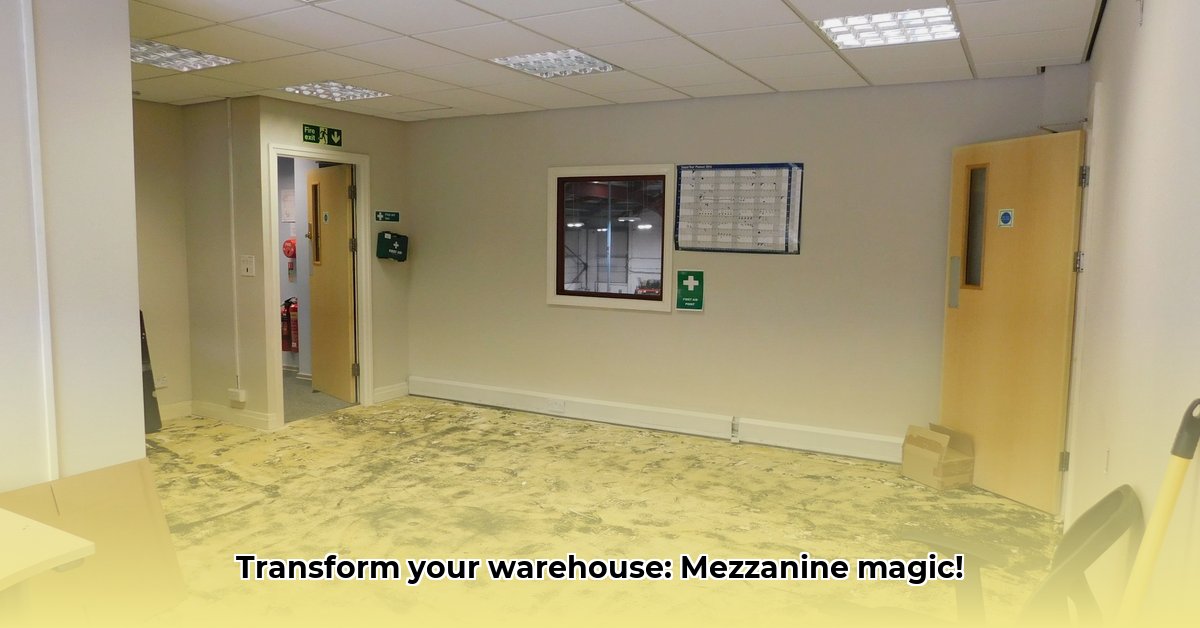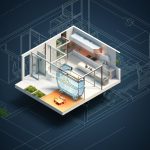Running out of room in your warehouse? Need more office space without the expense of relocating? Building a mezzanine office is a smart solution. This comprehensive guide walks you through planning, construction, safety considerations, and cost analysis. We’ll cover mezzanine types, design best practices, regulatory compliance, and workflow optimization to help you create a more efficient and productive workspace. For more warehouse solutions, check out this helpful resource.
Mezzanine Floor for Office Space: Unlocking Your Warehouse’s Hidden Potential
Is your warehouse cramped? Are you facing rising rent costs and expansion challenges? A mezzanine office floor can significantly increase usable space without the massive financial burden of relocation or new construction. It’s a strategic investment that pays dividends in efficiency and productivity.
Leveraging Vertical Space for Efficiency
A mezzanine office floor is essentially a second story constructed within your existing warehouse footprint. This efficiently utilizes otherwise wasted vertical space, creating a functional workspace, additional storage capacity, or dedicated equipment areas. Think of it as building “up” instead of “out.” This approach offers a cost-effective alternative to traditional expansion methods, maximizing your existing assets.
Compared to expanding outward, which involves land acquisition, new foundations, and potentially disrupting existing operations, a mezzanine leverages what you already have.
Step-by-Step Mezzanine Construction Guide
Careful planning is crucial before starting any construction project, especially a mezzanine office. Follow these steps for a smooth, efficient, and safe mezzanine construction process:
-
Needs and Space Assessment: Conduct a detailed evaluation of your warehouse layout, current space utilization, and projected office space requirements. Determine the specific types of work to be performed in the new office, the necessary equipment to be installed, and the number of employees who will occupy the space. This thorough assessment helps avoid costly redesigns and ensures the mezzanine meets your long-term needs. Consider future growth and scalability during this phase.
-
Expert Consultation (Design and Engineering): Engage a qualified structural engineer specializing in mezzanine installations to create detailed blueprints, specify appropriate materials, and rigorously ensure structural integrity. This step guarantees a structurally sound, safe, and code-compliant mezzanine. Ensure the engineer is licensed in your jurisdiction and has experience with similar projects. Obtain detailed engineering reports and calculations for your records.
-
Permit Acquisition: Secure all necessary permits and approvals from local authorities and regulatory bodies, including comprehensive fire safety inspections and ADA (Americans with Disabilities Act) compliance reviews. Obtaining these permits is not merely a formality; it’s essential to avoid legal issues, fines, and potential work stoppages. Research specific permit requirements well in advance, as the process can be time-consuming.
-
Material Selection: Choose construction materials based on your budget, operational needs, and aesthetic preferences. Options include engineered wood (e.g., plywood, glulam), OSB (oriented strand board), steel grating, concrete, or composite materials. Carefully consider weight capacity, durability, fire resistance, maintenance requirements, and aesthetics. Consider the load-bearing capacity of the materials in relation to the intended use of the mezzanine.
-
Installation and Finishing: Hire a professional and experienced construction team specializing in mezzanine construction to ensure strict adherence to building codes, engineering specifications, and safety regulations. Add appropriate flooring (e.g., carpet, tile, epoxy), lighting (e.g., LED fixtures, natural light integration), HVAC (heating, ventilation, and air conditioning) systems, electrical wiring, and other office amenities to create a comfortable and functional workspace. Ensure proper insulation for energy efficiency and climate control.
-
Employee Training: Provide comprehensive safety training to all employees who will access or work on the mezzanine, covering emergency procedures (e.g., evacuation routes, fire extinguisher use), safe mezzanine access protocols (e.g., proper use of stairs, ladders, or lifts), and hazard awareness. This ongoing training ensures the safe and efficient use of the new space and minimizes the risk of accidents. Conduct regular refresher training sessions and document all training activities.
Mezzanine Floor Advantages and Disadvantages
Weigh the benefits against potential drawbacks before committing to a mezzanine project. Understanding these factors allows for informed decision-making and proactive mitigation of potential challenges.
| Advantages | Potential Drawbacks |
|---|---|
| Significant increase in usable floor space | Upfront investment costs, including design, materials, and labor |
| Cost-effective compared to warehouse expansion or relocation | Potential disruptions to warehouse operations during installation |
| Improved workflow and operational efficiency | Ongoing maintenance requirements and potential repair expenses |
| Increased employee satisfaction and productivity | Limitations on ceiling height and load-bearing capacity of the existing structure |
| Customizable design to meet specific business needs | Requires expert engineering, building permits, and compliance with safety regulations |
| Enhanced storage capabilities | Potential for increased noise levels if not properly soundproofed |
| Improved inventory management | May require adjustments to existing fire suppression systems |
Addressing Key Concerns
Several common questions and concerns typically arise during mezzanine planning and installation. Addressing these proactively ensures a smoother project and a more satisfactory outcome.
-
Structural Soundness: Robust engineering design, adherence to building codes, and regular inspections are the keys to ensuring the long-term structural soundness of a mezzanine. Engage qualified structural engineers to conduct thorough inspections at regular intervals to identify potential problems early on, preventing costly repairs and ensuring safety. Consider the dynamic loads that the mezzanine will experience, such as from forklifts or moving equipment.
-
Safety Compliance: Mezzanines must scrupulously meet OSHA (Occupational Safety and Health Administration) guidelines, IBC (International Building Code) standards, and all applicable local building codes to ensure a safe working environment. Install safety features such as handrails, guardrails, stairways with proper rise and run, and clearly marked emergency exits. Conduct regular safety audits to identify and address potential hazards.
-
Budgeting and Costs: Develop a detailed and realistic budget that includes all anticipated costs, such as design fees, materials, labor, permits, inspections, and contingency funds for unexpected expenses. Obtain multiple detailed quotes from different contractors and suppliers to ensure you are getting competitive pricing. Carefully compare quotes and scrutinize the fine print. Consider the long-term cost of ownership, including maintenance and potential repairs.
-
Workflow Integration: Design the mezzanine to seamlessly integrate with your existing warehouse workflow, minimizing disruptions and maximizing efficiency. Carefully consider the placement of stairs, elevators, and material handling equipment to optimize the flow of people and goods. Conduct a thorough workflow analysis to identify potential bottlenecks and inefficiencies.
Building a mezzanine office floor is a worthwhile undertaking that can significantly enhance your warehouse operations. By following the outlined steps, understanding potential impacts, addressing concerns proactively, and prioritizing safety and compliance, you can unlock valuable space, boost productivity, and create a more efficient and comfortable workspace for your employees.
How to Compare Mezzanine Office Installation Costs from Different Manufacturers
Comparing mezzanine office installation costs requires a systematic approach to ensure you get the best value for your investment. Understanding the factors that influence pricing and knowing how to evaluate quotes is essential.
Key Takeaways:
- Mezzanine floor costs can vary significantly based on materials (e.g., AdvanTech OSB, ResinDek, concrete), design complexity, building needs, and geographical location.
- Obtaining accurate cost estimates requires providing manufacturers with precise project details, including dimensions, load requirements, and desired features.
- Labor costs typically represent a substantial portion of the total installation expense, so it’s crucial to get detailed labor estimates from multiple contractors.
- Material properties, such as load-bearing capacity, fire resistance, and moisture resistance, are critical for choosing the right flooring solution for your specific needs.
- Don’t forget to factor in long-term maintenance, potential replacement costs, and the impact of downtime during installation on your business operations.
Effectively compare mezzanine office installation costs from different manufacturers by breaking down the cost components and understanding the value proposition of each option.
Material Cost Breakdown
The comparison process starts with understanding the price differences between common flooring materials like AdvanTech OSB, ResinDek composite, and concrete. Each material offers a unique set of advantages and disadvantages in terms of cost, durability, and performance.
-
AdvanTech: Budget-friendly option known for its moisture resistance. Costs typically range around $1.80 to $2.50 per square foot, depending on thickness and quantity.
-
ResinDek: Mid-range composite material offering excellent durability and customization options. Priced around $2.30 to $3.50 per square foot, depending on the specific configuration.
-
Concrete: High-strength flooring solution suitable for heavy-duty applications. Costs around $3.25 to $5.00 per square foot, including installation and finishing.
These are approximate estimates, and actual prices can fluctuate significantly based on market conditions, supplier pricing, and project-specific requirements. It’s essential to obtain current pricing from multiple suppliers before making a decision.
Identifying Hidden Costs
Several hidden costs often influence the final installation price. Being aware of these potential expenses can help you avoid unpleasant surprises and make more informed budgeting decisions.
-
Sub-Flooring: The supporting structure beneath the flooring material (e.g., metal decking or support beams) can add significantly to the overall cost. The complexity of the sub-flooring design will impact the material and labor expenses.
-
Installation Labor: Complex mezzanine designs, tight spaces, and difficult access can increase labor expenses. Be sure to get detailed labor estimates from multiple contractors and compare their hourly rates and project timelines.
-
Permits and Inspections: Expenses
- Glass Mosaic Backsplash: A Stylish Upgrade For Your Kitchen - December 8, 2025
- Glass Tile Shower Ideas to Create a Stunning Bathroom Space - December 7, 2025
- Glass Wall Tile Ideas for Kitchens and Bathrooms - December 6, 2025










